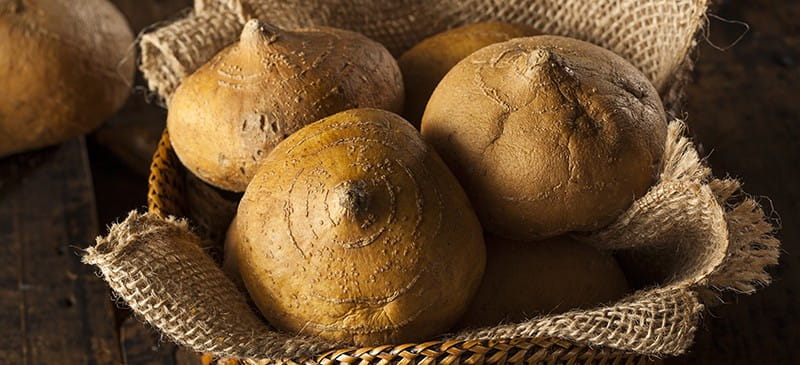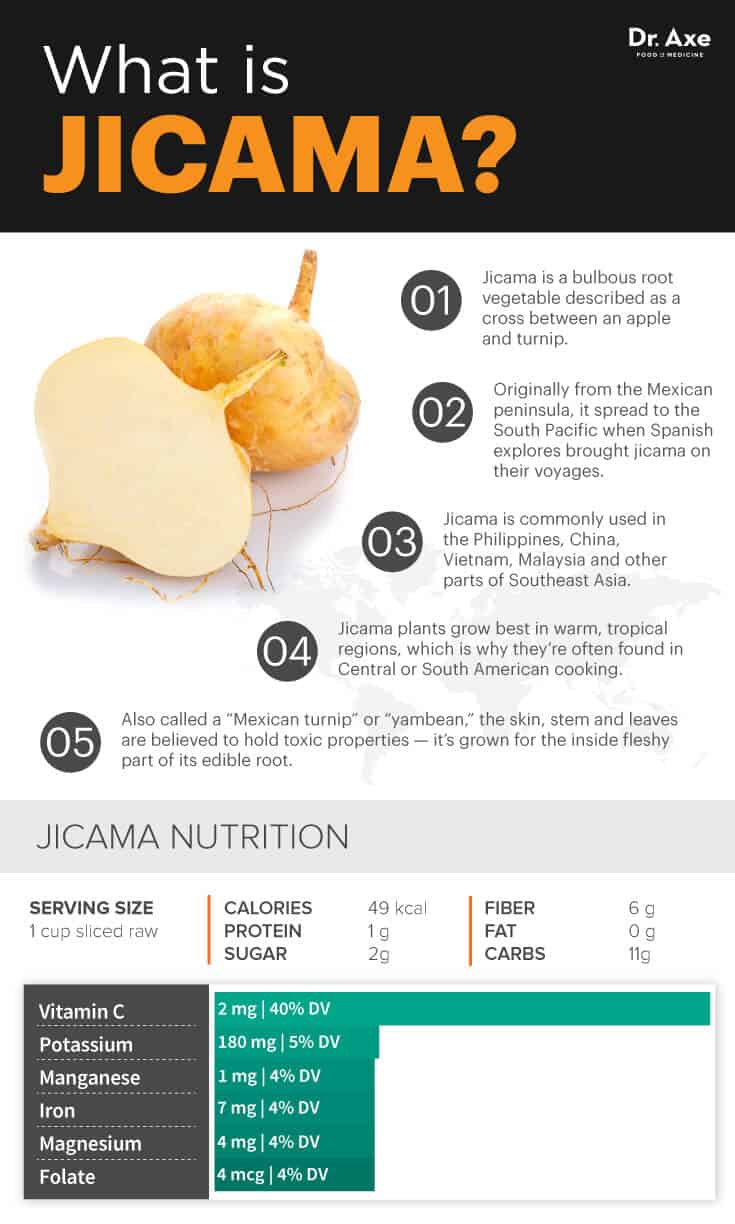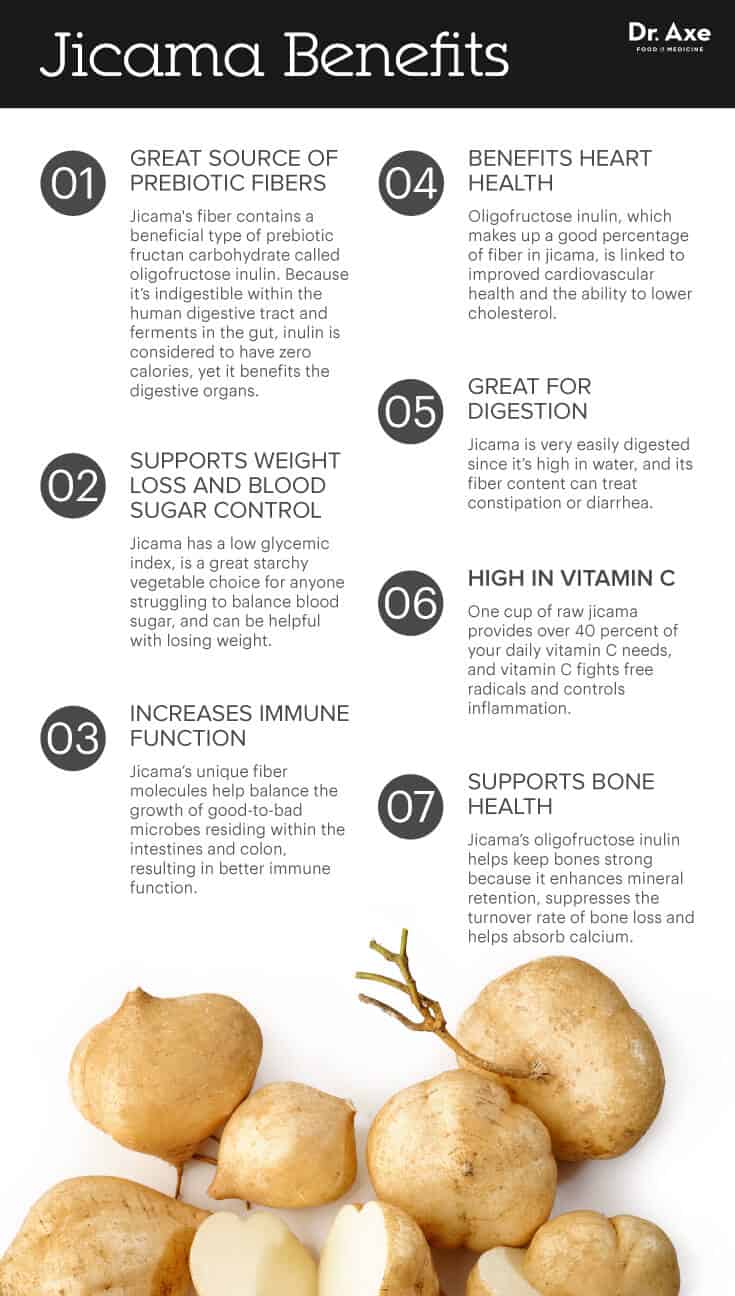Jicama: A Root Vegetable with a Unique Flavor
Jicama (also called yambean) is a type of bulbous root vegetable that many people describe as being a cross between an apple and a turnip.
Originally from the Mexican peninsula, jicama has played an important part in traditional cuisines of populations living in Central and South America, the Caribbean, and parts of Asia from thousands of years.

What Is Jicama?
Although some people mistake jicama for a fruit, it’s technically the root of a type of bean plant and a member of the legume plant family called Fabacea. It has the plant species name Pachyrhizus erosus.
Is jicama a starch? Is it low in calories and carbs? This veggie is composed of about 86 percent to 90 percent water, so it’s naturally low in calories, natural sugars and starch — and, therefore, it has a low score on the glycemic index. It fits most diets, including the vegan, Paleo and the ketogenic diet plan.
Other jicama nutrition benefits include that it’s a good source of immune system-boosting nutrients such as vitamin C, magnesium, potassium and fiber.
Where is jicama grown? The jicama plant grows best in warm, tropical regions, which is why this veggie is found in Central or South American cooking. The plant itself is grown only for the inside fleshy part of the edible root, since its skin, stem and leaves are believed to have toxic properties.

Nutrition
According to the USDA, one-cup serving of sliced raw jicama (pronounced hee-cama) has about:
- 49 calories
- 0 fat
- 6 grams dietary fiber
- 1 grams protein
- 11 grams carbs
- 2 grams sugar
- 2 milligrams vitamin C (40 percent DV)
- 180 milligrams potassium (5 percent DV)
- 1 milligram manganese (4 percent DV)
- 7 milligrams iron (4 percent DV)
- 4 milligrams magnesium (4 percent DV)
- 4 micrograms folate (4 percent DV)
Benefits
1. Great Source of Prebiotic Fibers
Although it’s a root veggie, jicama is surprisingly low in starch, sugar and carbs compared to other vegetables like potatoes, turnips, beets and rutabaga. Where jicama really stands out is its standing as a high-fiber food — with about 25 percent of your daily dietary fiber needs in every one-cup serving.
Jicama’s fiber contains a beneficial type of prebiotic fructan carbohydrate called oligofructose inulin. Because it’s indigestible within the human digestive tract and ferments in the gut, inulin is considered to have zero calories, yet it benefits the digestive organs and, therefore, your entire body (including the immune system) in a few different ways.
Inulin acts like a prebiotic once it reaches the intestines, which means it helps probiotics (or “good bacteria” living within the GI tract) do their job best.
Inulin-type fructans are found in mostly plant roots that are high in fiber (including jicama or chicory root). Studies show these wind up residing in the gut and fermenting to produce a higher perchance of bacteria populations including bifidobacteria. In the process, beneficial compounds called butyrate, lactic acid and SCFA are formed.
Research suggests that inulin-type fructans have anticarcinogenic and anticancer properties, including offering protection against colon cancer. They can also positively stimulate the immune system, support weight control, and more.
2. Supports Weight Loss and Blood Sugar Control
Why is jicama good for diabetics? As a veggie high in fiber, jicama also has a low glycemic index and is therefore a great starchy vegetable choice for anyone struggling to balance their blood sugar. It may also be helpful for losing weight fast, too.
In studies, jicama extract has shown positive inhibitory effects against factors that raise blood sugar levels, including postprandial hyperglycemia (from α-glucosidase and α-amylase reactions).
When comparing reactions of diabetic mice receiving jicama supplements to those not, one study found an increase in postprandial blood glucose levels was more significantly suppressed in the jicama group compared to the control group.
When digested, high-fiber foods also expand in your stomach and absorb water, so it’s important for keeping you full.
3. Helps Increase Immune Function
As a source of valuable prebiotics, jicama’s unique fiber molecules help balance the growth of good-to-bad microbes residing within the intestines and colon. A very large percentage of the immune system — over 75 percent — is actually stored with your GI tract, so proper immune functioning depends a lot on a delicate balance between the bacteria populating your microbiota.
According to results from a 2005 British Journal of Nutrition study, prebiotic plant foods that contain inulin-type fructans have chemo-protective properties and are capable of lowering your risk for colon cancer. They do this by fighting the impact of toxins and carcinogens in the gut, reducing tumor growth, and stopping metastasizing (spreading).
Researchers found natural cancer-fighting effects of inulin-type fructans on pre-neoplastic lesions (ACF) or tumors in the colons of rats and mice, especially when prebiotics were given in combination with probiotics (called synbiotics).
It’s believed that eating jicama can provide prebiotics that help improve protection from cancer because of gut flora-mediated fermentation and the production of butyrate. Most people don’t eat enough prebiotics, so including more raw jicama in your diet is one way to help up your intake and foster protection against cell mutations and tumor growth within the digestive organs.

4. Benefits Heart Health
Like many vegetables, jicama has a high water and nutrient density, and is otherwise largely made of different types of carbohydrate molecules.
Oligofructose inulin, which makes up a good percentage of the fiber found in jicama, is linked to improved cardiovascular health and the ability to lower cholesterol naturally.
A diet that includes plenty of high-fiber foods is capable of improving arterial health and reducing inflammation, therefore offering protection against heart disease. It can also lower the risk for developing metabolic syndrome, high cholesterol or blood pressure, diabetes, and insulin resistance.
Other nutrients found in jicama that may fight heart disease include vitamin C (a powerful anti-inflammatory and that fights free radicals) and potassium (important for controlling blood pressure levels).
5. Great for Digestion
Water and fiber-rich vegetables are recommended for anyone battling digestive issues because they’re hydrating and provide fiber, essential electrolytes and nutrients that support intestinal and gut health.
Jicama is considered by experts to be a very easily digested veggie since it’s high in water, and its fiber content can naturally relieve constipation or treat diarrhea.
Jicama also is an anti-inflammatory food that can reduce flare-ups in the GI tract associated with IBS, ulcers, leaky gut syndrome and autoimmune digestive disorders.
6. High in Antioxidant Vitamin C
Eating jicama is a good way to increase your intake of certain antioxidants, including vitamin C. Just one cup of raw jicama provides over 40 percent of your daily vitamin C needs.
Vitamin C is a crucial antioxidant that scavenges free radical damage and controls inflammation. Eating plenty of vitamin C foods helps control inflammation, which is important for keeping oxidative stress levels lower and protecting against cancer, autoimmune diseases, cardiovascular disease and cognitive decline.
7. Supports Bone Health
Jicama’s oligofructose inulin helps keep bones strong because it enhances mineral retention, suppresses the turnover rate of bone loss and helps with the absorption of calcium into bones.
It also supplies important nutrients like potassium, magnesium and manganese that studies show are needed for proper bone mineralization and protecting against bone loss or osteoporosis into older age. That’s why jicama should be added to any osteoporosis diet natural treatment.
Related: What Is Daikon Radish Good For? Nutrition, Benefits & Recipes
How to Eat
How does jicama taste like? It’s slightly sweet, crunchy and mild, so it can be eaten raw or cooked. It has a crisper and lighter texture than most root veggies, since it’s higher in water and lower in starch. It looks much like a turnip but has a taste and feel closer to an apple.
If you’re familiar with Asian pears or water chestnuts used in Asian cooking, you can imagine jicama feeling and tasting pretty similar — with a crisp, somewhat juicy, white interior.
Look for whole jicama bulbs at large supermarkets and Latin or Asian grocery stores. You want to buy jicama when it feels firm, looks yellow to beige in color, and doesn’t have any noticeable bruises.
Once home, keep (preferably uncut) jicama in a cool, dark place. Just like other root veggies, it won’t spoil for several weeks when left whole in the refrigerator, but once you cut into it, try to use it within several days before it dries out.
How to Cook
Jicama is super versatile both in terms of preparation needed and what types of flavors it pairs well with. Keeping some pre-chopped, roasted or sliced jicama sticks on hand is even a smart way to replace some of the processed grains in your diet.
In order to use this veggie, you first have to remove the firm skin. Unlike other root veggies such as potatoes that have edible skins, the peels are tough to digest and even contain a type of molecule called rotenone that should be avoided.
Luckily, it doesn’t have to be cooked in order to enjoy it, so you can just peel it, slice off the top or bottom to create a flat surface, and then cut it into strips or cubes with a sharp knife.
To cook jicama:
- Peel jicama root and cut into pieces or about 1/4 inch matchsticks to make “fries.”
- If making boiled pieces, bring water to boil over medium heat and cook for 10 minutes until jicama is less crunchy. Drain and toss with ingredients like olive oil, paprika, garlic powder, onion powder, salt, etc.
- If making fries, place in a single layer on a prepared baking sheet and bake for 30-45 minutes or until crispy at 425°F, turning halfway.
What fruits or veggies can you use as jicama substitutes? Apples, pears, turnips, golden beets and water chestnuts all make good subs.
Recipes
Called a “Mexican turnip” or yambean in some parts of the world, jicama is used in many cuisines around the world, including in the Philippines, China, Vietnam, Malaysia and other parts of Southeast Asia.
Some of its popular uses include pickling it in rice vinegar and salt (in the Philippines), making it into bagoong shrimp paste, blending it into fruit bars or spicy fruit salad, and even baking and sweetening it to be used as an ingredient in pie (in Vietnam).
- You can use raw jicama sticks to dip into Guacamole or hummus instead of chips.
- Throw some slices into your salad for extra crunch, or roast it just like potatoes or turnips.
- Make a jicama salad using thin slices like you would of fennel, mixed with other greens.
- Thinly slicing pieces of jicama with a mandolin slicer to make jicama fries, or lightly baking wide slices to make jicama tortillas or chips.
- Add it raw to homemade salsa, or use jicama chip in place of corn chips.
Often used in Mexican recipes, its flavors combine really well with benefit-rich avocado, sea salt, peppers of all kinds and lime. It also works well with apples or pears, Asian flavors like soy sauce or ginger, oranges, and Mediterranean ingredients like garlic and chives.
Try adding jicama to some of these healthy, easy recipes:
- Mango Avocado Salsa Recipe
- Chunky Tomato Salsa Recipe
- 36 Taco Recipes to top with jicama slaw
- Sweet Potato and Beet Hash Browns Recipe
Final Thoughts
- What is jicama? It’s a root vegetable that goes by many names around the world, such as yam bean and mexican potato. It has similarities to turnips, water chestnuts and apples in terms of its texture, appearance and taste.
- Benefits of jicama nutrition include: providing prebiotics (a plant fiber that stimulates the growth and activity of good bacteria in the gut), fiber, vitamin C, potassium, magnesium and manganese.
- It’s low in calories, high in filling fiber and water, and a good way to increase intake of antioxidants. It may help to protect against heart disease, colon cancer, diabetes/insulin resistence, and support weight loss.





Leave a comment